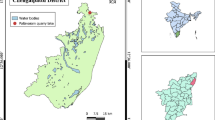Abstract
Fishes that live in the Amazon environment may be exposed to several kinds of water: black water (BW), acidic black water (pH 3.5) (ABW) and white water (WW), among others. The aim of the present study was to analyze net ion fluxes in the facultative air-breather Hoplosternum littorale (tamoata) and the obligate air-breather Arapaima gigas (pirarucu) exposed to different types of water. Fishes were acclimated in well water and later placed in individual chambers containing one type of water for ion flux measurements. After 4 h, the water in the chambers was replaced by a different type of water. The transfer of both species to ABW (independent of previous water exposure) increased net ion loss. Tamoatas transferred from ABW to BW or WW presented a net ion influx, but pirarucus showed only small changes on net ion efflux. These results allow us to conclude that tamoatas and pirarucus present differences in terms of ion regulation but that the general aspects of the ion flux are similar: (1) exposure to ABW led to net ion loss; (2) transfer from BW to WW or vice-versa induced only minor changes on net ion fluxes. These observations demonstrate that any osmoregulatory difficulties encountered by either species during changes between these latter two waters can be easily overcome.




Similar content being viewed by others
References
Affonso EG (2001) Respiratory characteristics of Hoplosternum littorale (Siluriformes, Callichthyidae). Acta Amazonica 31:249–262
Araújo-Lima C, Goulding M (1997) So fruitful a fish. Ecology, conservation and aquaculture of the Amazon’s tambaqui. Columbia University, New York
Barthem R, Goulding M (1997) Os bagres balizadores. Ecologia, migração e conservação de peixes amazônicos. Sociedade Civil Mamiraua, Brasília
Brauner CJ, Matey V, Wilson JM et al (2004) Transition in organ function during the evolution of air-breathing; insights from Arapaima gigas, an obligate air-breathing teleost from the Amazon. J Exp Biol 207:1433–1438
Gonzalez RJ, Wilson RW (2001) Patterns of ion regulation in acidophilic fish native to the ion-poor, acidic Rio Negro. J Fish Biol 58:1680–1690
Gonzalez RJ, Dalton VM, Patrick ML (1997) Ion regulation in ion-poor acidic water by the blackskirt tetra (Gymnocorymbus ternetzi), a fish native to the Amazon River. Physiol Zool 70:428–443
Gonzalez RJ, Wood CM, Wilson RW et al (1998) Effects of water pH and calcium concentration on ion balance in fish of the Rio Negro, Amazon. Physiol Zool 71:15–22
Gonzalez RJ, Wilson RW, Wood CM et al. (2002) Diverse strategies for ion regulation in fish collected from the ion-poor, acidic Rio Negro. Physiol Biochem Zool 75:37–47
Matsuo AYO, Val AL (2003) Fish adaptations to Amazonian blackwaters. In: Val AL, Kapoor BG (eds) Fish adaptations. Science Publ, Enfield
Mortatti J, Probst JL (2003) Silicate rock weathering and atmospheric/soil CO2 uptake in the Amazon basin estimated from river water geochemistry: seasonal and spatial variations. Chem Geol 197:177–196
Patrick ML, Part P, Marshall WS et al (1997) Characterization of ion and acid-base transport in the fresh water adapted mummichog (Fundulus heteroclitus). J Exp Zool 279:208–219
Pereira Filho M, Roubach R (2005) Pirarucu (Arapaima gigas). In: Baldisserotto B, Gomes LC (eds) Espécies nativas para piscicultura no Brasil. Editora da Universidade Federal de Santa Maria, Santa Maria
Playle RC, Wood CM (1989) Water chemistry changes in the gill microenvironment of rainbow trout—experimental observations and theory. J Comp Physiol B – Biochem Syst Environ Physiol 159:527–537
Sioli H (1984) The Amazon and its main affluents: hydrography, morphology of the river courses, and river types. In: Sioli H (ed) The Amazon: limnology and landscape ecology of a mighty tropical river and its basin. W. Junk, Dordrecht
Tardy Y, Bustillo V, Roquin C et al (2005) The Amazon. Bio-geochemistry applied to river basin management Part I. Hydro-climatology, hydrograph separation, mass transfer balances, stable isotopes, and modelling. Appl Geochem 20:1746–1829
Wilson RW (1996) Ammonia excretion in fish adapted to an ion-poor environment. In: Val AL, Almeida-Val VM, Randall DJ (eds) Physiology and biochemistry of the fishes of the Amazon. INPA, Manaus
Wilson RW, Wood CM, Gonzalez RJ et al. (1999) Ion and acid-base balance in three species of Amazonian fish during gradual acidification of extremely soft water. Physiol Biochem Zool 72:277–285
Wood CM, Wilson RW, Gonzalez RJ et al (1998) Responses of an Amazonian teleost, the tambaqui (Colossoma macropomum), to low pH in extremely soft water. Physiol Zool 71:658–670
Zall DM, Fisher MD, Garder QM (1956) Photometric determination of chlorides in water. Anal Chem 28:1665–1678
Acknowledgements
This study was supported by CNPq (Brazilian National Research Council) grant numbers 475093/2003-8 and 506943/2004-6. B. Baldisserotto, L. C. Gomes and R. Roubach are research fellowship recipients from the CNPq. The authors are also thankful to Dr. Ira Brinn (UFRJ) for English corrections.
Author information
Authors and Affiliations
Corresponding author
Rights and permissions
About this article
Cite this article
Baldisserotto, B., Copatti, C.E., Gomes, L.C. et al. Net ion fluxes in the facultative air-breather Hoplosternum littorale (tamoata) and the obligate air-breather Arapaima gigas (pirarucu) exposed to different Amazonian waters. Fish Physiol Biochem 34, 405–412 (2008). https://doi.org/10.1007/s10695-008-9200-y
Received:
Accepted:
Published:
Issue Date:
DOI: https://doi.org/10.1007/s10695-008-9200-y




